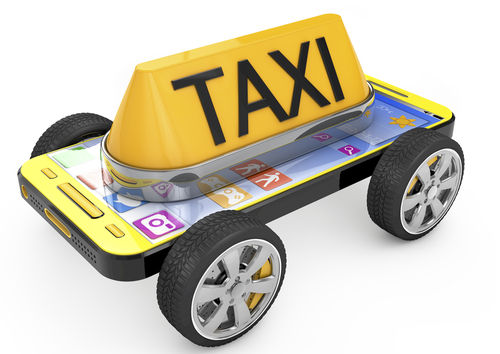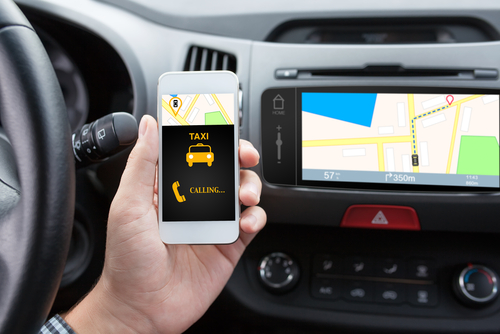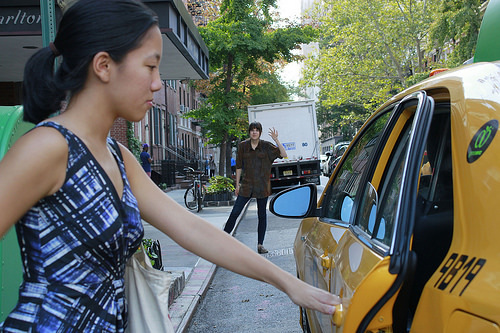One lawmaker wants to help taxis compete with Uber, nationwide
Could you one day use a single app, in cities all across the nation, to hail a taxi and pay for it just as you can with Uber or Lyft? Montgomery County is trying to make that happen with a new law proposed by county councilmember Hans Riemer.

Smartphone as taxi image from Shutterstock.
Today, ride-hailing services like Uber and Lyft have many advantages over traditional taxis. They get a car to come to you and tell you how long you’ll have to wait. They connect you with the driver en route. They control quality to make sure drivers have clean and well-maintained cars and treat customers well. At the end of the ride, you don’t have to deal with payment — the app takes care of it.
When ride-hailing services burst onto the scene, taxis did almost none of these. You could call one, but in some places, often had little guarantee one would even show up at all. In DC, there are dozens of different cab companies, so even calling one meant picking a company and hoping one of their cars was available. And you’d have no idea if the car that showed up was even clean.
Incumbent taxi drivers complained that ride-hailing app services weren’t playing on a level field; they didn’t have to deal with the same level of regulation, for instance. In many US jurisdictions including DC, Maryland, and Virginia, there are now laws putting some regulations on ride-hailing companies but not every one that applies to taxis.
Can taxis have their own ride-hailing app?
There have also been efforts to help taxis compete with Uber and Lyft. The app Hailo, for instance, provided an Uber-like service but for participating taxis; it could also show you nearby cabs, hail one, track it, and handle payment. I enjoyed using it and found the drivers it worked with both pleasant and knowledgeable about how to navigate the city, but sadly Hailo suddenly shut down in October 2014 after operating for a little over a year, saying it couldn’t compete with Uber and Lyft.
After that, former DC Taxi Commission head Ron Linton tried to get taxi drivers to collaborate on an app. A new driver co-op would provide every driver with the smartphone to log onto the service, and drivers could choose to receive hails through the app.
A contractor is working on this app, but nothing has materialized yet. It also seemed unlikely that an app managed by a taxi co-op would have close to the polish of Uber and Lyft, or Uber’s uber-large marketing budget. And who would handle customer service issues? Would someone kick out bad drivers in rattletrap cars?
 Taxi hailing image from Shutterstock.
Taxi hailing image from Shutterstock.
Is there another way?
Hans Riemer, an at-large councilmember in Montgomery County, and his staff proposed a different approach, which passed into law in a recent taxi bill: let any company create an app to hail taxis, Uber-style, but also require them to share data so that any app can access all of the taxis.
In other words, say there are three Uber-like services, GreenCab, BlueCab, and PurpleCab, all operating in Montgomery County. Each one has a stable of about 50 drivers who use its software, and each has an app consumers can download.
For the rider, there is a problem: To get a taxi, the rider might need to try all three apps in case there are no GreenCab cars nearby but there are PurpleCab cars. Under Riemer’s plan, if the local Department of Transportation approves all three apps, they would have to share the car locations, so the PurpleCab app could show the BlueCabs and vice versa, or someone else could create their own app that shows them all.
Every driver would be legally required to work with at least one of the companies, ensuring that all taxis are available to riders to call.
This has advantages over the “co-op” plan because there’s an opportunity for competition. Instead of taxis having just one company and just one app, which could be clunky and bureaucratic, a more nimble company could always come in and start competing by building a better app.
This system isn’t exactly like Uber
If it gets off the ground, this could give taxi drivers a great way to participate in the app-based market. In jurisdictions with few Uber or Lyft cars, getting all existing taxis on a system could actually offer more choices than using one of those services. Also, taxi drivers often know more about navigating their area than many inexperienced Uber drivers.
On the other hand, Uber and Lyft compete with taxis on more than quality of the app and number of cars; there is customer service, price, and the quality of the vehicles. In some cities, like DC, a big complaint about legacy cabs is that some are in very bad shape. A taxi hailing system, either the co-op or Riemer’s plan, doesn’t duplicate every element of ride-hailing.
Hailo, when it was operating, only worked with a subset of cabs, and in my anecdotal experience, they were generally better-maintained and had friendlier, more knowledgeable drivers than the random cab you might hail. Under a taxi dispatch system, there would not be an equivalent of the “star” rating system where riders can give feedback about their driver. Nor would drivers get kicked out for getting low ratings.
Still, taxis don’t have to be exactly like Uber. If they can just make it easy for a rider to request one, see how far away it is, contact the driver, and pay without having to pull out cash or a credit card, just like on a ride-hailing service, that would help existing taxis compete and offer riders more choice.
If every city does this…
Riemer hopes that more cities and counties will follow a similar model and make their open data feeds follow a common standard. If that comes to pass, a rider of the hypothetical BlueCab app could not only get any Montgomery County taxi, but travel to another place and be able to hail a local cab even if the BlueCab company has no cars there.
With Capital Bikeshare, for example, there’s a publicly-accessible electronic file of where the docks are located and how full they are. That file is the same for every system using Bixi-based technology, which means that if someone writes an app for Washington, it works in a lot of other cities with almost no extra code.
Transit systems has a standard, called GTFS, which they use to share route and schedule data. An app to show you a bus route in one city can work, with little extra effort, in thousands of cities.
This is a big advantage for Uber and Lyft right now. A user of one of those services can fly to a new city and pull out the same, familiar app. If Riemer’s vision comes to pass, the same could happen for your local taxi hailing app as well.
For now, the Montgomery County DOT is writing specific regulations to implement the law Riemer passed. Those will work out many of the details. The DOT and Riemer’s staff have also spoken to technology companies that might create such apps.

